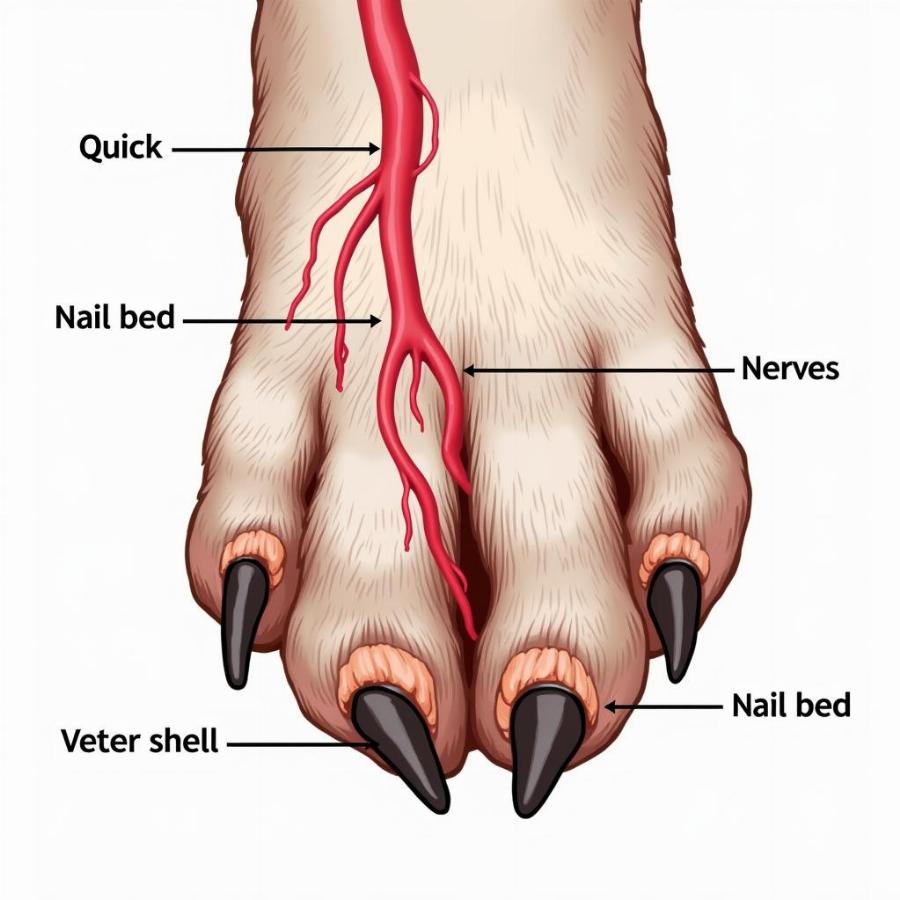The anatomy of a dog’s toenail is more complex than it appears. Understanding its structure is crucial for proper nail care and can help prevent painful injuries and infections. Knowing the different parts of your dog’s toenail—the quick, the nail bed, and the nail itself—allows you to trim their nails safely and effectively. This article will delve into the intricacies of a dog’s toenail anatomy, providing you with valuable knowledge to keep your furry friend happy and healthy.
The Key Components of a Dog’s Toenail
A dog’s toenail comprises three main parts: the quick, the nail bed, and the hard outer shell. The quick is the pink, fleshy part of the nail that contains nerves and blood vessels. Cutting into the quick is painful and can cause bleeding. The nail bed lies beneath the quick and provides support for the nail. Finally, the nail itself is the hard outer shell made of keratin, the same material that makes up human fingernails and hair.
 Cấu tạo móng vuốt của chó
Cấu tạo móng vuốt của chó
Why Understanding Dog Toenail Anatomy Matters
Knowing the anatomy of a dog’s toenail is essential for safe and effective nail trimming. Trimming too close to the quick can cause pain, bleeding, and infection. Overgrown nails can also lead to discomfort, difficulty walking, and even skeletal problems. Therefore, understanding the anatomy of a dog’s toenail empowers owners to maintain their dog’s paw health.
How Long Should a Dog’s Toenail Be?
Ideally, a dog’s toenails should not touch the ground when they are standing. You should be able to slip a piece of paper between the nail and the floor. If the nails click on the floor, they are too long.
Safe Nail Trimming Techniques
Using the right tools and techniques is vital for safe nail trimming. Sharp clippers designed specifically for dogs are essential. Guillotine clippers or scissor-type clippers are commonly used. It’s also helpful to have styptic powder on hand in case of accidental bleeding.
How to Find the Quick in Dark Nails?
Finding the quick in dark nails can be challenging. Look for a small, dark circle on the underside of the nail. This is the beginning of the quick. Trim small bits of the nail at a time, starting from the tip. If you see a dark, moist circle appear in the center of the nail, stop trimming, as you are close to the quick.
Common Toenail Issues
Several common toenail issues can arise if proper nail care is not practiced. These include broken nails, ingrown nails, and infected nails. Recognizing these issues early and seeking veterinary care when needed is crucial. clipped dog toenails bleeding can be a common issue, so it’s important to understand how to address it. Similarly, knowing what to do when you cut dog toenail too short is crucial. For a deeper understanding of the paw itself, check out our article on the anatomy of dog’s paw. If you notice my dog’s toenail is slightly bleeding, it’s essential to take action.
Conclusion
Understanding the anatomy of a dog’s toenail is fundamental for responsible pet ownership. By learning about the quick, the nail bed, and the nail itself, you can confidently trim your dog’s nails, preventing pain and potential health problems. Regular nail trims and proper care contribute significantly to your dog’s overall well-being.
FAQ
- How often should I trim my dog’s nails? It depends on the breed and how quickly the nails grow, but generally every 2-4 weeks.
- What type of nail clippers should I use? Guillotine or scissor-type clippers designed specifically for dogs.
- What should I do if I cut the quick? Apply styptic powder to stop the bleeding.
- Can I take my dog to a groomer for nail trims? Yes, many groomers offer nail trimming services.
- What are the signs of an infected toenail? Swelling, redness, pus, and lameness.
- Why are my dog’s nails so thick? Age, breed, and lack of regular trimming can contribute to thick nails.
- How can I make nail trimming easier for my dog? Get your dog used to having their paws handled from a young age.
Beaut Dogs is a comprehensive resource for dog lovers, offering expert advice on all aspects of dog ownership. We provide in-depth guides on dog breeds, care, training, and much more. Beaut Dogs is dedicated to empowering dog owners with the knowledge they need to provide the best possible care for their furry companions. When you need support, please contact us via Email: [email protected] for detailed and accurate answers from Beaut Dogs.